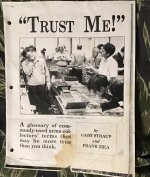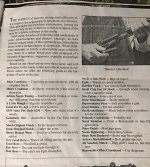I'm working on the 2023 Edition of Standard Catalog of Firearms and need help with a sticky question that's been bugging me for the past couple editions. It concerns the value of (relatively) recently introduced firearms models in lower grades of condition. These would be guns made with modern materials (plastics, alloys, etc.) and metal finishes other that tradition bluing (stainless, matte, etc.), and especially modern designs. In the S&W field this would include M&P rifles & pistols, etc.
Let's call them "New Types" for shorthand.
I'm trying to figure out what a "Fair" condition M&P 15 or other New Type gun would sell for as a percentage of the NIB or Exc value. AND whether "Fair" condition New Type guns ever actually exchange hands in the marketplace.
It seems to me that it takes years (decades?) of steady use to knock these types of guns down a few condition grades. I think the vast majority of them haven't been around long enough, and aren't used enough, to get beat up enough to drop a couple of condition grades from NIB or Excellent. For example, an AR in "Fair" condition would have "some finish remaining." "Good" condition would have "over half" the finish remaining.
My past practice has been to only list recently introduced gun values in NIB and Excellent condition. Once the model has been around a few years I may add "Very Good." I've contended that if a New Type gun has enough use & abuse to fall below that condition grade, it tends to be more likely to be salvaged for parts than sold on the market.
Has anyone seen New Type guns actually sell in Good, Fair or Poor condition? How does their price compare to one in Excellent condition?
I'd appreciate any thoughts on how lower condition New Type guns should be value-guesstimated.
Thanks in advance - Jim
For reference, below are the firearms condition definitions I use in Standard Catalog of Firearms (based on the NRA definitions).
NIB – NEW IN BOX
100% original finish. The gun is exactly as it left the manufacturer. It has not been fired and has no wear. It is in its original factory carton or case with all of the paperwork and accessories that originally came with the gun. All original parts. In this book, NIB is listed only for Modern guns. Antique guns that are in New in Box condition are extremely rare and will bring a substantial premium over an Antique Excellent specimen.
EXCELLENT
An Excellent condition Modern or Antique Gun must be in perfect working condition with unmarred stock or grips. It has an excellent bore, and perfect sharp markings and decoration. It must be completely factory original with no refinish, repair, alterations, or additions of any kind, with factory original sights.
• Modern Excellent - At least 98% original metal and wood finish.
• Antique Excellent - At least 80% original finish.
FINE (Antiques only)
• Antique Fine - 30% to 80% original finish. Minor marks in wood. Good bore. Sharp original lettering, markings, and designs. “Fine” is not used to describe modern guns.
VERY GOOD
A Very Good condition Modern or Antique Gun must have all factory original major parts and be in good working order. It may have some small blemishes, repairs, alterations, or non-factory additions. Markings and decoration are distinct and sharp. No refinishing, pitting, or corrosion.
• Modern Very Good - 90% to 98% original finish. Good bore.
• Antique Very Good - 0% to 30% original finish, or most of a period-of-use professional refinish or factory refinish. Wood may be slightly scratched or dinged. Bore condition is disregarded.
GOOD
A Good condition Modern or Antique gun may have minor repairs, alterations, or non-factory additions. It should be in safe working condition. Main markings should be visible.
• Modern Good – Over half original finish or most of a professional refinish. Bore may have some wear or corrosion.
• Antique Good - Usually no original finish. Metal may be smoothly rusted or lightly pitted in places, and may have been lightly cleaned or professionally refinished. Stock or grips may be scratched or dinged with repaired minor cracks, or may be a correct well-fit replacement. Bore condition is disregarded.
FAIR
Fair condition Modern or Antique guns include those that show heavy use and cosmetic neglect, or have had major non-professional alterations or refinishing. Markings may not be legible, with the important exception that it is not legal to possess a modern firearm with an obliterated serial number. Stock or grips may be replaced or show heavy use or repaired cracks.
• Modern Fair - Generally has some finish remaining. Must be in satisfactory working order and safe to shoot.
• Antique Fair - May be lightly pitted overall, vigorously cleaned, or refinished with rounded edges. If not working, must be repairable. If working, must be safe to shoot.
POOR
Both modern and antique guns will have little to no finish remaining, and may show pitting and rust. Parts may be broken or missing. They may not be working and may not be safe to shoot.
• Modern Poor - Usually these guns are so far gone that they are valued primarily for their salvageable parts.
• Antique Poor - Some heavily worn or rusted antique guns may have some value as conversation-piece relics or representative examples of a rare specimen.
Let's call them "New Types" for shorthand.
I'm trying to figure out what a "Fair" condition M&P 15 or other New Type gun would sell for as a percentage of the NIB or Exc value. AND whether "Fair" condition New Type guns ever actually exchange hands in the marketplace.
It seems to me that it takes years (decades?) of steady use to knock these types of guns down a few condition grades. I think the vast majority of them haven't been around long enough, and aren't used enough, to get beat up enough to drop a couple of condition grades from NIB or Excellent. For example, an AR in "Fair" condition would have "some finish remaining." "Good" condition would have "over half" the finish remaining.
My past practice has been to only list recently introduced gun values in NIB and Excellent condition. Once the model has been around a few years I may add "Very Good." I've contended that if a New Type gun has enough use & abuse to fall below that condition grade, it tends to be more likely to be salvaged for parts than sold on the market.
Has anyone seen New Type guns actually sell in Good, Fair or Poor condition? How does their price compare to one in Excellent condition?
I'd appreciate any thoughts on how lower condition New Type guns should be value-guesstimated.
Thanks in advance - Jim
For reference, below are the firearms condition definitions I use in Standard Catalog of Firearms (based on the NRA definitions).
NIB – NEW IN BOX
100% original finish. The gun is exactly as it left the manufacturer. It has not been fired and has no wear. It is in its original factory carton or case with all of the paperwork and accessories that originally came with the gun. All original parts. In this book, NIB is listed only for Modern guns. Antique guns that are in New in Box condition are extremely rare and will bring a substantial premium over an Antique Excellent specimen.
EXCELLENT
An Excellent condition Modern or Antique Gun must be in perfect working condition with unmarred stock or grips. It has an excellent bore, and perfect sharp markings and decoration. It must be completely factory original with no refinish, repair, alterations, or additions of any kind, with factory original sights.
• Modern Excellent - At least 98% original metal and wood finish.
• Antique Excellent - At least 80% original finish.
FINE (Antiques only)
• Antique Fine - 30% to 80% original finish. Minor marks in wood. Good bore. Sharp original lettering, markings, and designs. “Fine” is not used to describe modern guns.
VERY GOOD
A Very Good condition Modern or Antique Gun must have all factory original major parts and be in good working order. It may have some small blemishes, repairs, alterations, or non-factory additions. Markings and decoration are distinct and sharp. No refinishing, pitting, or corrosion.
• Modern Very Good - 90% to 98% original finish. Good bore.
• Antique Very Good - 0% to 30% original finish, or most of a period-of-use professional refinish or factory refinish. Wood may be slightly scratched or dinged. Bore condition is disregarded.
GOOD
A Good condition Modern or Antique gun may have minor repairs, alterations, or non-factory additions. It should be in safe working condition. Main markings should be visible.
• Modern Good – Over half original finish or most of a professional refinish. Bore may have some wear or corrosion.
• Antique Good - Usually no original finish. Metal may be smoothly rusted or lightly pitted in places, and may have been lightly cleaned or professionally refinished. Stock or grips may be scratched or dinged with repaired minor cracks, or may be a correct well-fit replacement. Bore condition is disregarded.
FAIR
Fair condition Modern or Antique guns include those that show heavy use and cosmetic neglect, or have had major non-professional alterations or refinishing. Markings may not be legible, with the important exception that it is not legal to possess a modern firearm with an obliterated serial number. Stock or grips may be replaced or show heavy use or repaired cracks.
• Modern Fair - Generally has some finish remaining. Must be in satisfactory working order and safe to shoot.
• Antique Fair - May be lightly pitted overall, vigorously cleaned, or refinished with rounded edges. If not working, must be repairable. If working, must be safe to shoot.
POOR
Both modern and antique guns will have little to no finish remaining, and may show pitting and rust. Parts may be broken or missing. They may not be working and may not be safe to shoot.
• Modern Poor - Usually these guns are so far gone that they are valued primarily for their salvageable parts.
• Antique Poor - Some heavily worn or rusted antique guns may have some value as conversation-piece relics or representative examples of a rare specimen.


